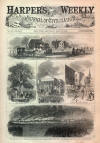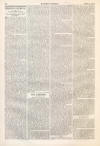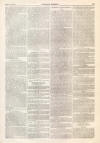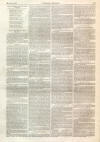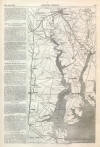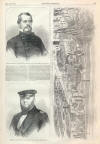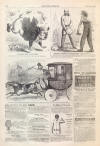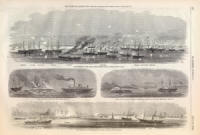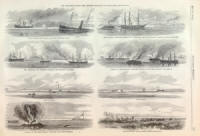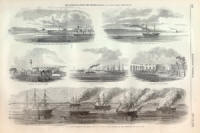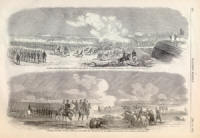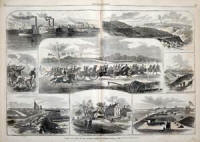|
This Site:
Civil War
Civil War Overview
Civil War 1861
Civil War 1862
Civil War 1863
Civil War 1864
Civil War 1865
Civil War Battles
Confederate Generals
Union Generals
Confederate History
Robert E. Lee
Civil War Medicine
Lincoln Assassination
Slavery
Site Search
Civil War Links
Civil War Art
Mexican War
Republic of Texas
Indians
Winslow Homer
Thomas Nast
Mathew Brady
Western Art
Civil War Gifts
Robert E. Lee Portrait
|
WHEN GREEN LEAVES COME
AGAIN.
BY THE AUTHOR OF "JOHN HALIFAX,
GENTLEMAN."
WHEN green leaves come again, my
love, When green leaves come again—
Why put on such a cloudy face,
When green leaves come again?
"Ah, this spring will be like the
last,
Of promise false and vain;
And summer die in winter's arms
Ere green leaves come again.
"So slip the seasons—and our
lives:
'Tis idle to complain:
But yet I sigh, I scarce know
why, When green leaves come again."
Nay, lift up thankful eyes, my
sweet! Count equal, loss and gain:
Because, as long as the world
lasts,
Green leaves will come again.
For, sure as earth lives under
snows,
And Love lives under pain,
'Tis good to sing with every
thing,
"When green leaves come again."
THE arrival of our special artist
with Commodore
Farragut's squadron enables us to illustrate
very fully on pages
324, 325,
and 326, the
splendid achievements of Commodore
Farragut's fleet in the Mississippi, including
THE CAPTURE OF NEW ORLEANS. The following extracts from our artist's letters
will serve to explain the pictures.
The fleet started to attack Forts
St. Philip and Jackson on 16th April. On 17th the rebels began to send down
fire-rafts, one of which we illustrate. Our artist says:
A
FIRE-RAFT.
I have just come from the deck,
having witnessed one of the finest sights it has ever been my lot to see. The
rebels sent down a scow, about one hundred feet long, filled with pine knots,
and well saturated with tar. The breeze was fresh from the southward, and it
burned upward finely, looking very much like a prairie fire. Signal was made for
boats to tow the raft away from the shipping, and about forty boats were manned
and sent away, each provided with grapnels and fire-buckets. The picket boats
Kineo and Kathadin worked around it, and fired one or two shells in it, but the
Westfield went up and ran her bow into it, and then played a powerful stream of
water on it. Now the boats found an opportunity, and went alongside and boarded
the fire-raft, and commenced bailing water into it, and in twenty minutes they
put the fire out. They then towed it ashore near where the one that came down in
the morning was moored. While this was going on the rebels had small row-boats
out watching the progress of their skill, and saw probably with regret their
inglorious results and our high enjoyment. No amusement they could possibly get
up could be more acceptable to our men. The mortar fleet sailors were in
ecstasies, and they extinguished the flames in short order, and received the
hearty cheers of the vessels as they passed along. With their two fire-rafts the
rebels have accomplished nothing, except to learn us how to handle them.
THE BOMBARDMENT.
The bombardment began on 18th and
lasted six days. The mortar vessels were grouped as shown in our picture.
They covered their mast-heads and
rigging with green tree branches, so that, while lying under the friendly
shelter of the trees near the forts, their masts appeared as trees over the tops
of the genuine ones. The vessels which lay on the other side of the river
covered their sides with tree branches, and if it were not for their masts one
could not tell there were any vessels there.
The artist says on 19th:
Our mortar vessels are working
well, and I learn they fire on an average eighty shells per day. According to
that estimate they most have thrown already about four thousand shells up to
noon to-day. It is becoming very tedious to hear nothing but bang, bang, bang,
all day and all night without having a knowledge of the effect of our effort,.
The effect of the bombardment was
thus described after the surrender:
The work is terribly shattered,
and the casemates are nearly broken in many places. The gun-boats yesterday
entirely destroyed one. Only a few men have been killed as yet. We have nearly
silenced the water-battery, disabled a 10-inch Columbiad, and knocked the
carriage of another to pieces. Our fire is represented as being terrific, and
the least damage causes so much consternation that it requires the utmost
efforts on the part of the officers to quiet the men. Our shells, when they
fall, bury themselves from twelve to fourteen feet in the earth close to the
fort, then explode, and make the whole fort fairly tremble with the shock.
Occasionally one bursts in the fort; but those which burst outside do the most
execution. There are about 1500 men in both forts, mostly foreigners, but
commanded by "gentle Southern bloods."
THE FLEET RUNS THE FORTS.
On 24th Commodore Farragut
determined to run past the forts. The fleet was formed in three divisions, and
proceeded to steam up the river. Our artist says:
At precisely twenty minutes of
four o'clock the enemy opened fire from Fort St. Philip. At that moment I
hoisted our largest Star-Spangled Banner at the peak, and then hastening
forward, decked the fore and main each with an emblem of power and justice.
Three American ensigns were floating in a gentle breeze. Full speed was given to
the ship, the engineers did their duty nobly, and on we went, as it were, into
the jaws of death. At the time the enemy opened fire the mortar vessels went to
work, and the rapidity with which they threw shells at the rebels was truly
wonderful.
At five minutes of four o'clock
our bow gun belched forth fire and smoke, and a messenger, in the shape of a
nine-inch shell, was sent to Fort Jackson—the work, by-the-way, which we were to
attend to. In a few minutes more the broadside firing was commenced. Both forts
were replying as fast as they could. Broadside after broadside was being
delivered to them in rapid succession, while the mortar vessels were adding to
the dreadful noise.
Shot, shell, grape, and canister
filled the air with deadly missiles. It was like the breaking up of a thousand
worlds—crash—tear—whiz! Such another scene was never witnessed by mortal man.
Steadily we steamed on, giving them shell, the forts firing rifle-shot and
shell, 10-inch Columbiads, 42, 32, and 24 pounder balls; and, to add to this
state of affairs, 13 steamers and the floating battery Louisiana, of the enemy,
were pouring into and around us a hail-storm of iron perfectly indescribable.
Not satisfied with their firing, fire-raft after fire-raft was lit and set
adrift to do their work of burning. The Ram was busy at work trying to shove
them under the bows of our vessel.
As we drew near abeam of the
forts we intermingled grape with shell, which had the effect to silence in a
measure the barbettte guns. The shot from the enemy, which for some time had
gone over us, now began to cut us through.
While in the port mizzen rigging
the Flag-officer narrowly escaped being hit with a rifle shell. A shell burst on
deck, and the concussion stunned Lieutenant George Heisler, of our Marine corps,
so that for a time his life
was despaired of. I started to go
forward to see how things were working there, and the wind of a huge rifle-shell
knocked the cap off my head. It was a time of terror. Our guns were firing as
rapidly as possible, and the howitzers in the tops were doing excellent
execution.
The rebel steamers were crowded
with troops, who fired volleys of rifle bails at us, most of which did us no
harm. One of them came near us, and I think I am safe in saying she contained
two hundred men. Our howitzers opened on them, and Captain Broome, of the Marine
corps, opened into her with two nine-inch guns.
An explosion—terrific yells—a
careen, and that fellow was done for. Their steamers were bold and fearless, but
no sooner did they come in sight of our gunners than they were sunk. The Varuna
sunk six of them one after another.
In the midst of this awful scene
down came a tremendous fire-raft, and the Ram shoved her under our port quarter.
The flames caught our rigging and side, and for a moment it seemed we must fall
a prey to the ravages of fire. A fire was also burning on the berth-deck. The
fire hose was on hand, and we soon subdued the flames, and gave the Ram a dose
of rifle shell. She, however, came up for us again, but some other vessel
tackled her and she hauled off. During this stage of affairs we grounded, and
our fate seemed sealed; but our men worked like beavers, and the engineers soon
got the ship astern and afloat. It defies the powers of my brain to describe the
scene at this time. The river and its banks were one sheet of flame, and the
messengers of death were moving with lightning swiftness in all directions.
Steadily we plied shell and grape, interspersed with shrapnel. Rebeldom began to
quake; her boats were fast being riddled by well-directed broadsides, and they
who were able made for the shore to run them on, so that they could save their
lives. Some were on fire and others were sinking. Our boys were cheering with a
hearty good-will, and well they might, for we had almost won the day, and we
were nearly past the forts. Our ship had been on fire three times, and she was
riddled from stem to stern. The cabin was completely gutted, the starboard
steerage all torn up, and the armory all knocked into "pi." My clothing was
strewn abaft decks, and I was obliged to pick it up piece by piece. The
manuscript of the bombardment came near to destruction by a rifle shell, which
tore up my room and killed one man.
After being under a terrific
fire for one hour and twenty minutes we were past the forts, badly cut up; a
shot hole through mainmast, two in stern, and several through us. I frankly
confess I am unable to describe the scene. Words can not express any adequate
idea of the engagement. Wrapped up in smoke, firing and being fired at, shot and
shell whistling like locomotive demons around, above, before, and in the rear of
you; flames from fire-rafts encircling you, splinters flying in all directions,
and shells bursting overhead! Can you imagine this scene? If you can, it is more
than I can describe as I would wish to.
THE RAM "MANASSAS."
The artist writes:
We steamed up to the Quarantine,
when lo! the Ram made his appearance, and saucily fired at the Richmond. The
Mississippi being near at hand, about ship for the black devil, and at him she
went with the idea of running him down. The Ram ran, but finding the Mississippi
gaining on him, he run his nose into the bank of the river, and immediately
about thirty men came up out of the hatch and run on shore. The Mississippi
fired two or three broadsides into her and boarded her, but finding she was of
no earthly account again fired into her, and she drifted down the river sinking
very fast.
Captain Porter of the
Mortar
Flotilla thus describes her last end:
Before the fleet got out of sight
it was reported to me that the celebrated
ram Manassas was coming out to attack
us, and, sure enough, there she was, apparently steaming along shore, ready to
pounce upon the apparently defenseless mortar vessels. Two of our steamers and
some of the mortar vessels opened fire on her, but I soon discovered that the
Manassas could harm no one again, and ordered the vessels to save their shot.
She was beginning to emit smoke from her ports, or holes, and was discovered to
be on fire and sinking. Her pipes were all twisted and riddled with shot, and
her hull was also well cut up. She had evidently been used up by the squadron as
they passed along. I tried to save her as a curiosity, by getting a hawser
around her and securing her to the bank, but just after doing so she faintly
exploded. Her only gun went off, and emitting flames through her bow port, like
some huge animal, she gave a plunge and disappeared under the water.
THE "VARUNA."
The gun-boat Varuna emulated the
Cumberland in this conflict. Our artist says:
Captain Boggs of the Varuna,
finding that a steamer (name unknown) was about to run into him, put the vessel
in such position that in being damaged he could repay it with interest. On came
a large steamer all clad with iron about the bow, and hit the Varuna in the
port-waist, cutting and crushing in her side. She dropped alongside and cleared
out to butt again. She hit the Varuna a second time, and while in a sinking
condition the Varuna poured the 8-inch shells into him so fast that the rebel
vessel was set on fire and driven on shore.
Captain Boggs of the Varuna
reports as follows:
I have the honor to report that
after passing the batteries, with the steamer Varuna under my command, on the
morning of the 24th, finding my vessel amidst a nest of rebel steamers, I
started ahead, delivering her fire both starboard and port at every one that she
passed. The first on her starboard beam that received her fire appeared to be
loaded with troops. Her boiler was exploded and she drifted to the shore. In
like manner three other vessels, one of them a gun-boat, were driven on shore in
flames, and afterward blew up. At six A.M. the Varuna was attacked by the
Morgan, iron-clad about the bow, commanded by Beverly Kennon, an ex-naval
officer. This vessel raked us along the port gangway, killing four and wounding
nine of the crew. Butting the Varuna on the quarter and again on the starboard
side, I managed to get three 8-inch shells into her abaft her armor, as also
several shot from the after rifled gun, when she dropped out of action,
partially disabled. While still engaged with her another rebel steamer,
iron-clad, and with a prow under water, struck us in the port gangway, doing
considerable damage. Our shot glancing from her bow, she backed off for another
blow, and struck again in the same place, crushing in the side; but by going
ahead fast the concussion drew her bow around and I was able, with the
port-guns, to give her, while close alongside, five 8-inch shell abaft her
armor. This settled her and drove her ashore in flames. Finding the Varuna
sinking I ran her into the bank, let go the anchors, and tied her up to the
trees. During all this time the guns were actively at work crippling the Morgan,
she making feeble efforts to get up steam. This fire was kept up until the water
was over the gun-trucks, when I turned my attention to getting the wounded and
crew out of the vessel. The Oneida, Captain Lee, seeing the condition of the
Varuna, had rushed to her assistance, but I waved her on, and the Morgan
surrendered to her, the vessel in flames. I have since learned that over fifty
of his crew were killed and wounded, and she was set on fire by her commander,
who burned his wounded with his vessel. I can not award too much praise to the
officers and crew of the Varuna for the noble manner in which they supported me,
and their coolness under such exciting circumstances, particularly when
extinguishing fire, having been set on fire twice during the action by shell.
In fifteen minutes from the time
the Varuna was struck she was on the bottom, with only her top-gallant
forecastle out of water.
The officers and crew lost every
thing they possessed, no one thinking of leaving their station until driven
thence by the water. I trust the attention of the department will be called to
this loss and compensation made to those who have lost their all.
THE CHALMETTE BATTERIES.
Our artist writes:
At a quarter of eleven we
discovered two works known as the Chalmette Batteries, one on each side of the
river. One, I should judge, contained ten and the other eight guns, The signal
was immediately made to prepare for
battle. No flag was flying on
either work, nor did they hoist one at any time. At eleven o'clock both
batteries opened fire on the Cayuga. Owing to the very swift current we were
unable to go ahead very fast, and it was five minutes after they opened fire
before we could fire a bow gun. The enemy cracked away at us, and the shot flew
around us very rapidly, most of their shot raking along our deck, and striking
on or near the poop. For twenty minutes we stood the fire without being able to
return a broad-side, which we knew would soon silence them. In the mean time the
other vessels were working with their bow guns on both works.
At the end of the twenty minutes
we were within about fifty yards of the battery of ten guns, one being a mortar.
Then we let drive a broadside. Its effect was terrible, and nearly silenced the
work. Another broadside of grape, five second shell, and a sprinkling of
shrapnel, finished that work; but as the rebels did not hoist a white flag, as
they should do, we gave them another touch up, three cheers, and then left them
to run as fast as they chose. The other battery was soon silenced, this ship
throwing in a broadside to aid in the good work. The enemy fired at us with
infantry, and an artillery company was coming to their support, when they found
it was of no use. I think the enemy lost quite a number of people in the
engagement. We lost one man, Thomas, captain of the forecastle and of a rifle
Parrott. It is supposed he was blown overboard by the wind of a passing ball,
and reached the shore in safety. I heard of one man being blown over-board from
the Brooklyn.
THE
DESTRUCTION OF COTTON SHIPS.
The artist says:
As we steamed along we found five
large ships on fire with full cargoes of cotton, and they were nearly consumed.
The people of the city afterward
told our sailors that on Thursday night the panic broke out in the city, and all
the cotton was brought out and set on fire, and that the mob could be scarcely
restrained from firing the public buildings and then the private dwellings. It
was a night not equaled by any thing, even in the French revolutions.
A band of desperadoes had charge
of affairs, and they were backed by Lovell, who, however, denies it; but he is
accountable for the destruction of property, as he set the example by firing his
own cotton first. A ram lay alongside of the levee, partially sunk, and her
wood-work was on fire. Another ram affair was sunk on the Algiers side of the
river. I one unable to obtain the details of the loss by fire to shipping and
cotton. It will be weeks before it can be ascertained, and I have a right to
suppose that we never will be able to give the full particulars of the wanton
destruction of property which has occurred in and around this city during the
last two days.
The river was filled with ships
on fire, and all along the levee were burning vessels, no less than eighteen
vessels being on fire at one time, and the enemy were firing others as fast as
they could apply the torch. Such Vandalism never was heard of. The atmosphere
was thick with smoke and the air hot with flames. It was a grand but sad sight.
Hundreds of thousands of dollars' worth of property was being wantonly
destroyed. At the levee, just by the Custom-house, lay a burning ram (the
Anglo-Norman).
THE
FLEET AT NEW ORLEANS.
The arrival of the fleet at New
Orleans is thus described:
The view from our decks was one
such as will never, in all human probability, be witnessed again. A large city
lay at our mercy. Its levee was crowded by an excited mob. The smoke of the
ruins of millions' worth of cotton and shipping at times half concealed the
people. While men were hastening up the levee, firing ships and river craft as
fast as possible, the people were rushing to and fro. Some of them cheered for
the Union, when they were fired upon by the crowd. Men, women, and children were
armed with pistols, knives, and all manner of weapons. Some cheered for
Jeff
Davis,
Beauregard, etc., and used the most vile and obscene language toward us
and the good old flag. Pandemonium was here a living picture. Order was to them
a thing past and forgotten, and the air was rent with yells of defiance.
At two o'clock Captain Bailey
went on shore, flying a flag of truce, to communicate with the authorities. As
the boat drew near the levee the mob cursed the flag and every thing pertaining
to it. It was with the greatest difficulty that the naval officers reached the
City Hall, where the City Council, the Mayor, and Major-General Lovell were
awaiting the arrival of our communications.
Flag Officer Farragut sent word
to the authorities that he demanded the surrender of the city of New Orleans,
and assured them of the protection of the "old flag." The city being under
martial law, the civil authorities of course could do nothing; but Major-General
Lovell, with all the pomposity he could command, and with all the bluster he
could make, said, "Sir, I will never surrender the city." He was politely
informed that the city was in our power and, as much as we regretted the wanton
destruction of property, we would not disturb them, provided they made no
demonstration against us. After some talk Lovell agreed to evacuate the city
with his troops (from eight to fifteen thousand), and turn the city over to the
civil authorities, and that they might do as they pleased. The interview was
carried on with dispatch, and Captain Bailey and Lieutenant Perkins (his aid)
took a carriage and returned to their boat. On the route they were insulted,
pistols pointed in their faces, and all manner of indignities offered to them.
The officer in charge of the boats—Acting-Master Morton—was the recipient of all
manner of insults, but suffered no bodily harm.
After dark I went on deck to see
New Orleans by gas-light. How changed the scene! A little over twelve months ago
miles of shipping lined the levee; the buildings hid behind the forests of masts
and rigging of vessels bearing the banners of all nations of the world. None
were here now. The busy hum of workmen and the cheery song of the sons of
Africa, who worked at night, was not to be heard. No hissing puff of steamers
going and coming to and from the cities on the banks of this great river. No
ships—no signs of life were present now. A few gas-lights were burning along the
levee, and the dull embers and heavy smoke gave proof of a reign of anarchy and
terror. The buildings were wrapped in a sombre light, and we felt that it was a
city clothed in sackcloth and ashes.
THE
BATTERIES UP THE RIVER.
These were taken as follows:
At three o'clock the four heavy
vessels—Hartford, Brooklyn, Richmond, and Pensacola—got under way and proceeded
up the river, with a view of silencing two batteries located just above
Carrolton. As we passed along the levee in the upper part of the city
considerable Union feeling was manifested by all classes.
At Jefferson City we saw the ways
from which the ram Mississippi was launched a week ago. The enemy were building
ways for the construction of another; but now the place was deserted by all
workmen, and quite a crowd of quiet spectators filled their places.
On arriving at Carrolton we began
to look out for the batteries; but it was not until we had passed some three
miles above that place that we found them, deserted, and fires burning along the
line of earth-works.
This ship dropped slowly
alongside, and Lieutenant Kautz, Engineer Purdy, and myself went on shore to
reconnoitre and spike the guns. On landing, quite a crowd of people gathered
around us, but made little or no demonstrations of joy or sorrow. We were told
that the work was called Fort John Morgan, and that it was constructed to
prevent an approach to New Orleans by the river from the northward.
It was an extended field-work,
reaching from the riverbank, as we believe, to Lake Pontchartrain. The work was
well constructed, and we traveled along its line for about two miles, and found
the following armament in it that far:
In the Work near the
river. Along the line.
Nine 42-pounders. Nine
24-pounder carronades.
Two 32-pounders. Four
18-pounders.
Five guns were dismounted, and
platforms and circles for thirteen guns, not mounted, were found. The mounted
guns were all spiked, with the exception of fifteen, which Mr. Purdy spiked. A
fire had been kindled under each gun-carriage, and they were nearly destroyed at
the time we visited it.
The magazine was empty, of
course. A good hot shot furnace was undisturbed, and about 1000 round of
32-pounder shot lay around, intermingled with broken stands of grape. Marks of a
hasty retreat were plainly visible, and we were informed that when we attacked
the Chalmette Batteries, below the city, the troops which were located in
Fort
John Morgan were transferred to the former place, and after their defeat they
came up here and carried away their remaining stores, took the Jackson Railroad,
and left.
Of the battery on the other side
of the river I have not yet learned any particulars. A boat from the Oneida went
there and spiked the guns, and then left. Dark coming on we dropped down the
river opposite Carrolton and anchored for the night.
SURRENDER OF THE FORTS.
Meanwhile
General Butler had
pushed his men through a bayou and landed them above Forts St. Philip and
Jackson. The commanders of those forts wished to resist still; but the men would
not fight, and even trained the barbette guns on their officers. They
surrendered accordingly. But the commander having subsequently blown up the
Louisiana Captain Porter put him in double irons.
NORFOLK REPOSSESSED.
WE publish on
page 321 several
pictures illustrating the Advance of our Army upon
Norfolk and its
"repossession" by General Wool; and on
page 331 a general View of the City,
showing the Navy-yard, etc, The former page is from sketches by our special
artist, Mr. Theodore R. Davis.
It is understood that the
expedition against Norfolk was mainly planned by
President Lincoln and
Mr.
Chase. General Wool embarked his troops on the evening of 9th, landed on 10th at
Willoughby Point, and marched to Norfolk without obstruction. Our artist writes:
HALF-WAY CROSS-ROADS.
At seven o'clock General Wool,
accompanied by
Secretary Chase, Generals Mansfield and Viele, landed at Ocean
View, and they were soon on the way to the front, the men cheering them as they
passed.
Upon the arrival of the party at
the Half-way Crossroads they were distant from Ocean View five miles, and, by
the short road to Norfolk, the same distance from that place.
The Half-way Cross-roads is as
picturesque a spot as one often sees, a greater portion of the place being
sheltered by magnificent willow oaks, the largest that I remember to have seen.
Under these trees were grouped, in the coziest manner, the Twentieth Regiment.
As General Wool and others drew
rein General Weber was questioning some dirty-looking fellows in gray that had
been taken prisoners. From them he learned that they were a portion of the
garrison of Sewall's Point, which had been evacuated by reason of our shelling
of the night previous, by which one man had been killed and several wounded. I
asked them what all the smoke was about. "Youse fellows throw some kind of
things that spill fire when they burst, and it just sot every thing in a blaze;
so we run into the woods and then we all run away." Candid, that.
THE
FLAG OF TRUCE.
As they approached the city they
were met by the Mayor. Mr. Davis says:
In the immediate environs of the
city, and in front of a group of low wooden houses, we saw a white flag being
waved. Upon advancing it was found to be a deputation of citizens, composed of
the Mayor and a portion of the Common Council, who had come out from the city to
see what terms would be demanded, and to present is letter from General Huger,
the purport of which was the fact that, being unable to retain possession of the
place, he had surrendered it into the hands of the city authorities. They, in
turn, upon being made acquainted with the requirements of the Government, were
ready to place the city once more under the control of the Federal Government.
The scene in the little room in
which the parties first met was unique in the extreme. The officers were
thoroughly bepowdered and fatigued, and Mr. Chase's fine features were funnily
disguised with the pulverized dust that had settled on all alike—the Mayor
nervously anxious, the Councilmen stubbornly so; the proprietor of the shanty
"sans habit," fists in his pockets and quid in his cheek.
ENTERING THE CITY.
The correspondents of the press
had gone before the General—the reporter of the Associated Press, Mr. Davis, of
Harper's Weekly, and the correspondent of the New York Herald.
As we entered the city the smoke
of the burning Navy-yard seemed a cloud about to fall with the suddenness of
wrath, and blot out the stain of treason with which the air seemed full.
Fortunately for us it did not this time. So we went on. The children scattered,
some of the boldest stopping an instant to say, "They ain't agoing to hurt you."
Then they grew more bold, as the young procession trailing after use grew in
length. The tramp of the cavalry escort, as it came in the distance, attracted
attention too. Blinds slammed, and the people peeped rather than looked. The
crowds upon the corners were quiet, through the city to the City Hall, and in a
moment the carriages and escort came up. A general rush was made by the people,
who by this time were out in force; but the Mayor, Mr. Lamb, turned quietly to
them, and in a few words explained that General Wool and staff must enter alone,
as they were to draw up the articles by which they were to be protected, and
that the people were to have more privileges than even he had hoped for. With a
cheer the steps of the building were vacated in an instant, and the party, weary
and dusty, entered the chamber accompanied by two or three officials only.
The Stars and Stripes were raised
over the Custom-house on 10th, at noon, the colors used being those of the Tenth
New York. They were flung to the breeze by Lieutenant Aaron B. Seely,
Quarter-master of that corps.
THE
NAVY-YARD DESTROYED.
The Sixteenth Massachusetts were
at once sent to Portsmouth to stay the tremendous fire then burning the
Navy-yard. The Thomas Seldon, one of the boats belonging to the Bay line of
steamers, was in flames. The gun-boats that were unfinished and could not be
moved were destroyed, as were the Brandywine, United States, and others—some
twenty vessels in all. The Navy-yard was totally destroyed, with all its
appurtenances. The dry dock, however, is, I think, uninjured. The city was
quiet—more quiet, I am told, than it has been for some time.
COMMODORE GOLDSBOROUGH.
Flag-officer
Louis M.
Goldsborough, whose portrait we give on
page 333, was born in the District of
Columbia. He is a citizen of the State of Maryland, but received his appointment
in the United States Navy from the District of Columbia.
His first entrance into the navy
bears date June 13, 1812. He has consequently been nearly fifty years in the
United States service, over eighteen of which he has passed at sea in the
various grades of the naval service. Among others, he commanded the Marion, 38
guns, in 1842, at the time she was attached to the squadron of Commodores
Ridgely and Morris at Brazil. In 1847 he commanded the Ohio, 74 guns, and
afterward commanded the Cumberland, 44 guns, and the Levant, 18 guns, at the
time those vessels were attached to the squadron of Commodore
Silas H.
Stringham, in the Mediterranean.
The date of his present
commission is September 14, 1855. He lately commanded the United States frigate
Congress, from which position he was appointed to command one half of the
Atlantic Blockading Squadron, superseding Commodore Stringham, who was formerly
in command. His flag-ship was the Minnesota, and his station for some time was
Fortress Monroe.
|
